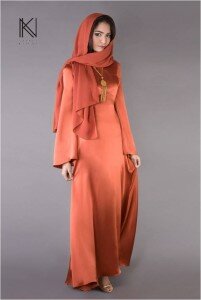-
The rise and rise of the Muslim fashion industry (part 2)
This week we’re continuing our deep dive insights into some of the trends of the growing world of Muslim fashion. Here is part 1 from last week, along with our introduction to the industry in the FT.
We’re still in full flow of wedding season in most parts of the world, but what should a bride do if she wants to be modestly dressed and fabulous on the big day? To answer this dilemma, bloggers and designers are springing up to address the idea that The Bride Wears Hijab. Brides-to-be can gain inspiration from Islamically-styled wedding outfits. Or even go to online retailers which specifically cater for Muslim brides.
Headscarves come in all sorts of shapes, styles, fabrics and prices. However, they bring with them the need for accompanying accessories: undercaps as a ‘base’, pins and clip for securing, and brooches and other decorative items. But that’s not all that the passionate hijabista needs.
Once you have a headscarf for every occasion and outfit, how do you store them? Here, here and here are three of the many different solutions to a problem that plagues the fashion conscious and which seems to have no definitive answer from mainstream storage brands.
Building a collection of stylish headscarves can be an expensive endeavour, so here women are given advice on how to take care of their precious investment.
Muslim fashion is a grass roots movement, and is taking off so vigorously because of the growing segment of young Muslims you we have identified as the Muslim Futurists, who believe that faith and modernity are complementary. The products they consume must be modern and cutting edge, but must also assist them in attaining the religious life that they aspire to. Here’s a great example of how a young Muslim woman achieves this through her fashion choices. “I have a friend who loved skinny jeans, but those tight trousers were a trouble when she made her wudhu [religious ablutions]. She then transformed the skinny jeans to be more wearable for shalat [prayer] by putting zippers on the bottom sides of the pants.” (spellings are Indonesian variants of Arabic words).
Indonesia has clear aspirations to be a world leader in Muslim fashion, and with a sizeable market already in place they seem well-positioned to do so. Designers like Dian Pelangi already have a following. But designers and bloggers are growing around the world – often designers start out as fashion bloggers and then progress from producing content to producing clothes. Dina Toki-o is British. Hana Tajima, American-Japanese; Ami Schaheera from Malaysia along with Shaelaiza.
Turkey also has a very vibrant Muslim fashion scene with upcoming brands include Aker, Kayra and Tugba Venn.
And across the Atlantic, American Muslim fashion is thriving. This video and article take a look “inside Muslim American fashion“. And in upcoming New York fashion week, designer Nzinga Knight ins incorporating her Islamic aesthetic into her clothing line which will show during the fashion festival, with long sleeves and long hems. But the clothes are for no shrinking violets. She says they are for “women who are going places.”
And that sentiment certainly seems to sum up the whole of Muslim women’s fashion: it is on the move, and that move is growing wider, more popular and into the mainstream.



Pingback: The rise and rise of the Muslim fashion industry (part 1) | Islamic Branding Consultancy & Marketing for Muslim Consumer Markets - Ogilvy Noor